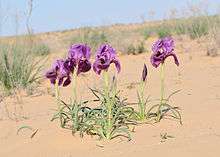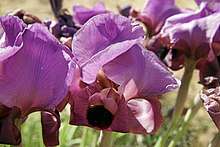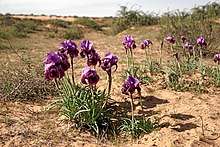Iris mariae
Iris mariae (also commonly known as Negev iris or Mary’s iris) is a species in the genus Iris, it is also in the subgenus Iris and in the section Oncocyclus. t is a rhizomatous perennial, from the deserts of Israel and Egypt. It is fairly tall, with long and slender glaucous leaves, and in late spring, lilac-purple to pinkish or violet flowers with deeper veining and blackish-violet signal and dark purple beard.
| Iris mariae | |
|---|---|
 | |
| Iris mariae from Northern Negev, Israel | |
| Scientific classification | |
| Kingdom: | Plantae |
| Clade: | Tracheophytes |
| Clade: | Angiosperms |
| Clade: | Monocots |
| Order: | Asparagales |
| Family: | Iridaceae |
| Genus: | Iris |
| Subgenus: | Iris subg. Iris |
| Section: | Iris sect. Oncocyclus |
| Species: | I. mariae |
| Binomial name | |
| Iris mariae | |
| Synonyms[1] | |
|
Iris barnumiae var. mariae (Barbey) Dykes | |
Description

It is a geophyte,[2][3] with a short rhizome.[4] Around 3cm long,[5] and it is stoloniferous.[6] Meaning it has several extremely long, secondary roots.[5]
It has 7-8,[6] glaucous, falcate (or sickle-shaped) leaves,[6][7][8] that are 10 to 12 cm (4 to 4.5 in) long,[4][5] and 0.4 to 0.6 cm (0 to 0 in) wide.[6] They are very similar to the Iris iberica.[5]
It has a stem that can grow up to 15–25 cm (6–10 in) tall.[9][10][11] Which is taller than the foliage.[5]
It flowers in late spring,[12] between February and March.[6][8][13]
The large flowers are 8–10 cm (3–4 in) in diameter,[12] and come in shades of lilac,[8] pinkish,[9][12] or violet.[10][7][11]
It has 2 pairs of petals,[2] 3 large sepals (outer petals), known as the 'falls' and 3 inner, smaller petals (or tepals, known as the 'standards'.[14] The recurved and darker falls,[9] are 5 cm (2 in) long and 2.5–3 cm wide,[6] with reddish brown,[12] or dark purple veining,[11][12] and a blackish-violet[10][11] or deep purple signal patch.[6][12][4] In the middle of the falls, also is a row of short hairs called the 'beard', which is black,[6][5] or purple.[12][9][10] The upright standards are larger and paler than the falls, and 6–6.5 cm (2–3 in) long and 4 cm wide.[6]
After the iris has flowered, it produces a seed capsule.
Biochemistry
As most irises are diploid, having two sets of chromosomes. This can be used to identify hybrids and classification of groupings.[14] It has a chromosome count of 2n=20.[5][10][11]
Two closely related iris species, Iris atrofusca and Iris mariae, were found to be clearly divergent genetically and phenotypically from each other.[15]
Taxonomy
It is commonly called 'Mary’s Iris' or 'Negev Iris'.[13][2][8]
It is written in Hebrew as איריס הנגב [13][2] and in Arabic script as سوسن النقب[2]
It was named after Mary, mother of Jesus,[8] and is sometimes incorrectly called Iris mairiae.[6][16]
It was originally found in Egypt,[17] and was first named by William Barbey as Iris helenae. Although, that name was already used by Koch for another Iris so M. Barbey has recently withdrawn the name Helenae and the proposed that of Iris mariae.[9] It was then published by Barbey in Oesterr. Bot. Z. Issue 41 on page 207 in 1891.[1][17][18]
It was also later published in Gartenflora 42: 343 in 1893, Krel. 1898; Van T. 1900; Van W. in 1906 and the 'Year Book of Iris Society' (Yr. Bk. I.S.(E.)) 43. in 1933.[9]
I. mariae is an accepted name by the RHS,[19] and it was listed in the RHS Plant Finder in 2012.[19] It was verified by United States Department of Agriculture Agricultural Research Service on 4 April 2003.[18] and listed in Encyclopedia of Life.[20]
Distribution and habitat

Iris mariae is native to temperate Asia.[18]
Range
It is endemic to Israel[8][12][21] and Egypt.[18][4][22]
Within Israel it is found in the Negev Desert,[2][3][7] (including Tze'elim[13] and Palestine (region)[6][20]) and within Egypt on the Sinai Peninsula.[6][10]
Within IUCN Red Data Book of 2006 there are 6 threatened plant species found near Lake Bardawil, Egypt these include Astragalus camelorum, Bellevalia salah-eidii, Biorum oliveri, Iris mariae, Lobularia arabica and Salsola tetragona.[23]
Conservation
It is becoming increasingly rare.[25] but in Israel, it is protected by law,[13][7] but still classed as 'endangered'.[20] Unfortunately most of its populations are located outside nature reserves.[7]
It is threatened by illegal harvesting (for the cut flower industry,[25]), climate change, urbanisation, and also from the impacts of modern agriculture.[8]
Cultivation
In Europe, it is hardy to Zone H4,[12] meaning hardy to -5 to -10oC (23 to 14oF)[26] −20 °C (−4 °F)
It usually requires very good drainage,[5] restricted water and protection from frosts, although keeping it barely dry during the winter, will make it more cold tolerant.[5][4]
The seed of the iris is deemed easy to germinate but growers should have some experience in growing others in this group of Irises.[22] The seed can be also grown using in-vitro seed germination.[21]
Toxicity
Like many other irises, most parts of the plant are poisonous (rhizome and leaves), and if mistakenly ingested can cause stomach pains and vomiting. Also, handling the plant may cause skin irritation or an allergic reaction.[27]
Variations
Known Iris mariae cultivars: 'Barnumae Mariae'
Known Hybrids;
Iris mariae crosses include;
Iris mariae X Iris atropurpurea ; 'Brown Prince',[28] 'Spiced Coffee'[29]
Iris mariae X Iris hermona ; 'Goren',[30] 'Sa'ar'
Iris gatesii X Iris mariae - 'Desert Gem'[31]
(Iris mariae X Iris samariae) X self - 'Adva'
Iris darwasica X Iris mariae - 'Hesperia'[32]
Iris korolkowii X Iris mariae; 'Andromache', 'Artemis',[33] 'Aspasia',[34] 'Dido', 'Eurydice',[35] 'Flora', 'Massilia', 'Medusa' and 'Una',
Oncogelia X Iris mariae - 'Bagdad Bauble'[36]
Regeliocyclus X Iris mariae - 'Saraglen'[9]
Uses
In 1970, a stamp series named 'Israeli Wild Flowers' was issued by Israel to celebrate Independence Day, it included Iris mariae.[37][38]
Then in February 2013, an ATM Label Negev Iris was produced, which has an image of the iris on it.[39]
References
- "Iris mariae Barbey is an accepted name". theplantlist.org. 23 March 2012. Retrieved 2 May 2018.
- "Negev Iris : Protected,Endangered". www.wildflowers.co.il. Retrieved 31 October 2019.
- David Ward The Biology of Deserts, p. 11, at Google Books
- "Iris mariae – RarePlants". www.rareplants.co.uk. Retrieved 31 October 2019.
- "chapitre I (partie 5) Les Oncocyclus II". dictionaire des iridacée (in French). irisbotanique.over-blog.com. Retrieved 30 November 2019.
- British Iris Society (1997) A Guide to Species Irises: Their Identification and Cultivation, p. 81, at Google Books
- Fragman-Sapir, Ori. "Negev Iris". Project Noah. Retrieved 31 October 2019.
- Blackhall-Miles, Robbie (25 December 2015). "Plant profile: Iris mariae". Robbie Blackhall-Miles. Retrieved 1 November 2019.
- Pries, Bob (25 July 2016). "SpecMariae < Spec < Iris Wiki". wiki.irises.org. Retrieved 31 October 2019.
- Kramb, D. "SIGNA: The Species Iris Group of North America". www.signa.org. Retrieved 31 October 2019.
- "Iris summary" (PDF). pacificbulbsociety.org. 14 April 2014. Retrieved 23 November 2014.
- James Cullen, Sabina G. Knees, H. Suzanne Cubey (Editors) The European Garden Flora Flowering Plants: A Manual for the Identification, p. 250, at Google Books
- "Mary's Iris". 101israel. Retrieved 29 October 2019.
- Austin, Claire (2005). Irises: A Gardener's Encyclopedia. Timber Press, Incorporated. ISBN 978-0881927306. OL 8176432M.}
- Volis, Sergei; Zhang, Yong-Hong; Deng, Tao; Dorman, Michael; Blecher, Michael; Abbott, Richard J (June 2019). "Divergence and reproductive isolation between two closely related allopatric Iris species". Biological Journal of the Linnean Society. 127 (2): 377–389. doi:10.1093/biolinnean/blz014.
- "Iris mairiae". nargs.org. Retrieved 12 November 2019.
- "Iridaceae Iris mariae Barbey". ipni.org (International Plant Names Index). Retrieved 2 May 2018.
- "Iris mariae". Germplasm Resources Information Network (GRIN). Agricultural Research Service (ARS), United States Department of Agriculture (USDA).
- "Iris mariae". rhs.org.uk. Retrieved 31 October 2019.
- Fragman-Sapir, Ori. "Iris mariae". eol.org. Retrieved 18 November 2019.
- Dorman, Michael; Melnikov, Pavel; Sapir, Yuval; Volis, Sergei (December 2009). "Factors affecting dormancy of Oncocyclus iris seeds". Israel Journal of Plant Sciences. 57 (4): 329–333. doi:10.1560/IJPS.57.4.329. Retrieved 1 November 2019.
- "Iris mariae – SEEDS OF PEACE". Retrieved 31 October 2019.
- M.A. Zahran and A.J. Willis The Vegetation of Egypt, p. 228, at Google Books
- Dorman, Michael; Sapir, Yuval; Volis, Sergei (1 October 2009). "Local adaptation in four Iris species tested in a common-garden experiment". Biological Journal of the Linnean Society. 98 (2): 267–277. doi:10.1111/j.1095-8312.2009.01265.x. Retrieved 1 November 2019.
- "Botanising Israel, an epic adventure of war and wildflowers, part 1". fossilplants.co.uk. 11 May 2014. Retrieved 2 May 2018.
- "Plant Hardiness". theseedsite.co.uk. Retrieved 20 December 2014.
- David G Spoerke and Susan C. Smolinske Toxicity of Houseplants, p. 236, at Google Books
- "Plant database entry for Aril Iris (Iris 'Brown Prince') with 19 data details". garden.org. Retrieved 4 December 2019.
- "Plant database entry for Aril Iris (Iris 'Spiced Coffee') with 17 data details". garden.org. Retrieved 4 December 2019.
- "Plant database entry for Aril Iris (Iris 'Goren') with 17 data details". garden.org. Retrieved 4 December 2019.
- "Plant database entry for Aril Iris (Iris 'Desert Gem') with 17 data details". garden.org. Retrieved 4 December 2019.
- "Plant database entry for Aril Iris (Iris 'Hesperia') with 9 data details". garden.org. Retrieved 4 December 2019.
- "Plant database entry for Aril Iris (Iris 'Artemis') with one image and 11 data details". garden.org. Retrieved 4 December 2019.
- Dykes, William (2009). "Handbook of Garden Irises" (PDF). beardlessiris.org (The Group for Beardless Irises). p. 78. Retrieved 1 November 2014.
- "Plant database entry for Aril Iris (Iris 'Eurydice') with 10 data details". garden.org. Retrieved 4 December 2019.
- "Plant database entry for Aril Iris (Iris 'Bagdad Bauble') with 22 data details". garden.org. Retrieved 4 December 2019.
- "Plants of the world on postage stamps". www.mgsforum.org. Retrieved 10 November 2019.
- "ISRAEL-CIRCA 1970: A post stamp printed in Israel shows flowers." 123RF. Retrieved 10 November 2019.
- "ATM Label Negev Iris - Israel Post Shop". www.israelpost.co.il. Retrieved 9 November 2019.
Other sources
- Boulos, L. 1995. Flora of Egypt checklist.
- Danin, A. 2004. Distribution atlas of plants in the Flora Palaestina area.
- Mathew, B. 1981. The Iris. 54-55.
- Sapir, Y. et al. 2002. Morphological variation of the Oncocyclus irises (Iris: Iridaceae) in the southern Levant. Bot. J. Linn. Soc. 139:369-382.
- Zohary, M. & N. Feinbrun-Dothan. 1966-. Flora palaestina.
External links
| Wikimedia Commons has media related to Iris mariae. |
![]()